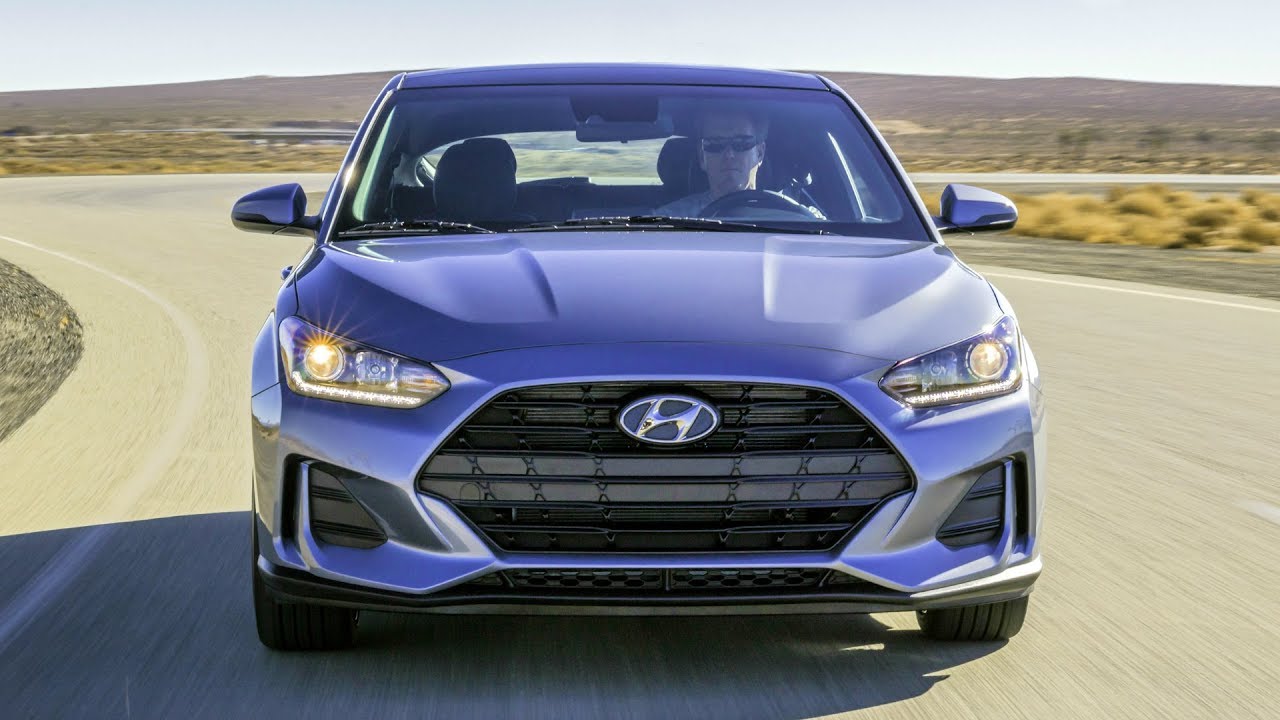2019 Hyundai Veloster – Focused on Performance. 2019 Hyundai Veloster – Drive, Interior and Exterior.
The Veloster merges the design appeal of a sport coupe with the versatility of an additional passenger side rear door in an asymmetrical two-plus-one configuration for easier rear-seat access. From the front, available LED headlights and LED Daytime Running Lights flank a striking new grille design. Functional air curtains add both a visual design cue and an active aerodynamic function. Hyundai’s signature cascade grille shape has morphed into a strong, three-dimensional design that sets the sport coupe apart.
Much of the redesign is derived from enhanced proportions and volume; the new shape clearly conveys focused dynamic performance, even standing still. Its stance is more muscular, with higher-volume fenders and wheel arches for a more planted appearance. The cowl point and A-pillar are further rearward and now connect the hood line and belt line into an integrated, powerful gesture. Available 18-inch alloy wheels aggressively fill the wheelhouse openings. Further, the roofline has been lowered for a unique profile and a distinctive coupe-inspired essence. The fender line is also more coupe-like, and the rear now has a more aggressive integrated diffuser design. Available LED taillights help complete the rear view with a high-tech appearance.
Also available is a full darkened roof treatment for a high-contrast performance appearance. Veloster’s dynamic rear design has a distinctive glass hatch and center-fascia chrome exhaust tips, with a single outlet for the 2.0-liter model and dual-outlets for Turbo and R-Spec models.
The asymmetrical design carries through to the interior, with a driver-focused interior layout and on the Turbo Ultimate, a contrasting color environment that visually separates the driving cockpit. Each trim level has unique colors, materials, and accents, further differentiating each model with varying hues and textures.
The 1.6-liter turbocharged, direct-injected four-cylinder engine produces 201 horsepower at 6,000 rpm (estimated) and 195 lb.-ft. of torque from 1,500-4,500 rpm (estimated). Turbo models generate 201 horsepower on regular fuel, which represents a best-in-class specific output of 125.6 horsepower per liter. Further, there is an over-boost function that raises peak torque output to 202 lb.-ft. under maximum acceleration. Engine tuning maximizes low- and mid-range torque, for optimum acceleration under daily driving conditions.
Veloster Turbo is paired with a standard six-speed manual transmission or a seven-speed dual clutch transmission (DCT). Both transmissions were developed in-house by Hyundai. The Veloster Turbo seven-speed dual-clutch transmission features steering wheel-mounted paddle-shifters and SHIFTRONIC® transmission gear control. In addition, all Veloster Turbo models feature Active Sound Design, which enhances intake and exhaust powertrain sound character inside the cabin for a more visceral driving experience, especially during spirited driving. Turbo models also offer three selectable driving modes, including Normal, Sport and Smart, according to driver preferences for engine, transmission and steering feel.
All Veloster models offer Torque Vectoring Control (TVC). This active cornering feature utilizing capabilities from the Electronic Stability Control (ESC) and powertrain control systems, allows Veloster to improve dynamic cornering during more enthusiastic driving. TVC uses wheel-speed sensors coupled with ESC algorithms to apply precise braking force to the inside front wheel during spirited cornering. This active braking redirects power to the outside front wheel in the turn, reducing wheelspin for enhanced cornering grip and corner-exit acceleration. Overall, this provides Veloster drivers with an incremental margin of cornering precision during enthusiastic driving.
Further, Veloster Turbo features a quicker-ratio steering rack and a revised steering calibration to match, which gives drivers precise cornering, feedback and control.
Hyundai’s EcoShift DCT takes the benefits of a manual transmission, such as low fuel consumption, and blends these with automatic transmission benefits, such as high comfort levels and driving ease. In addition, the DCT enables direct connection for high efficiency and uninterrupted torque transfer during shifts. The DCT also incorporates Hyundai’s Hillstart Assist Control (HAC), designed to minimize rolling backwards on steep ascents.
Veloster’s compelling combination of performance with efficiency is a formula many industry competitors are seeking to duplicate. Hyundai’s development focus on all the factors of efficient performance, such as small-displacement turbocharged engines, dual-clutch transmissions, comprehensive lightweighting, efficient aerodynamics, and reduction of parasitic engine losses through electric-powered ancillaries, have combined to yield simultaneous benefits in performance and efficiency to the consumer.









